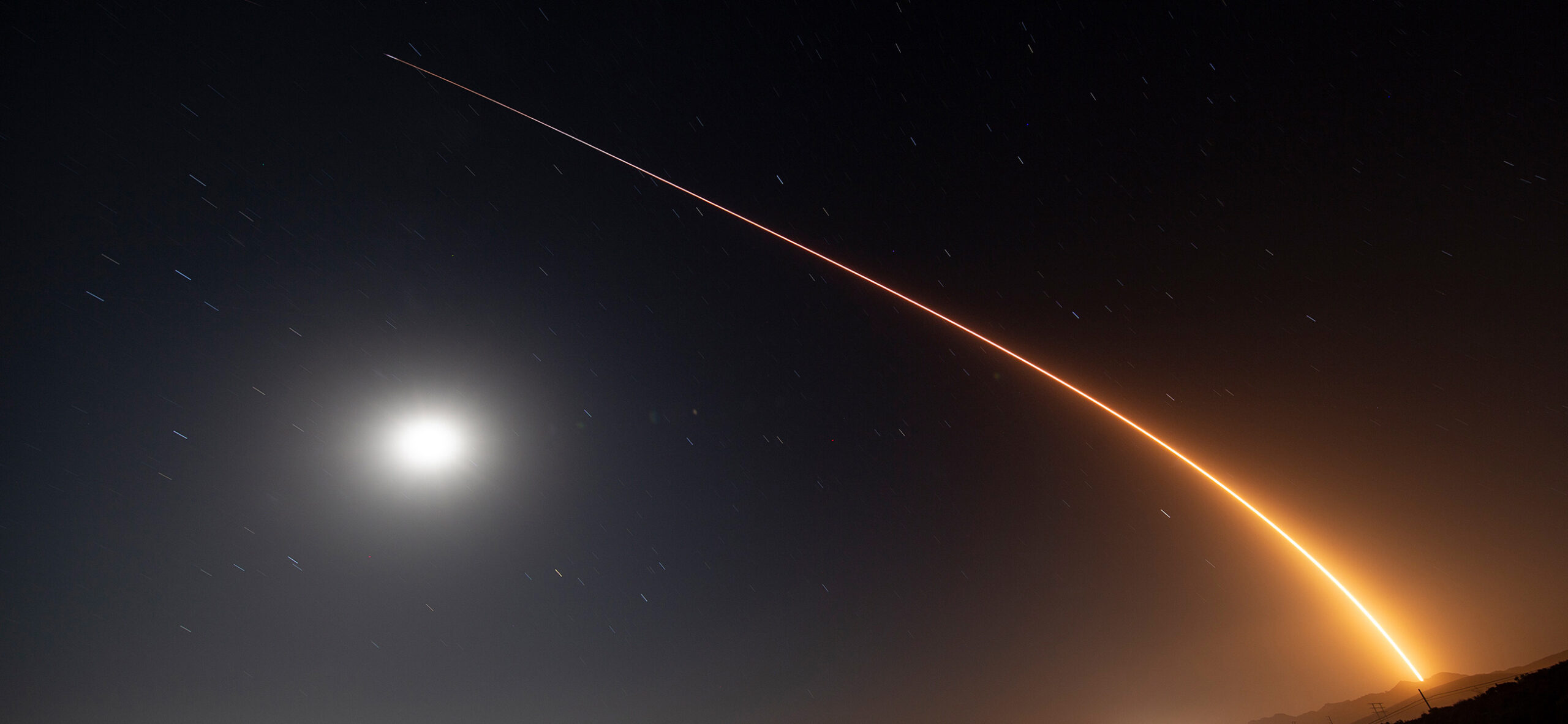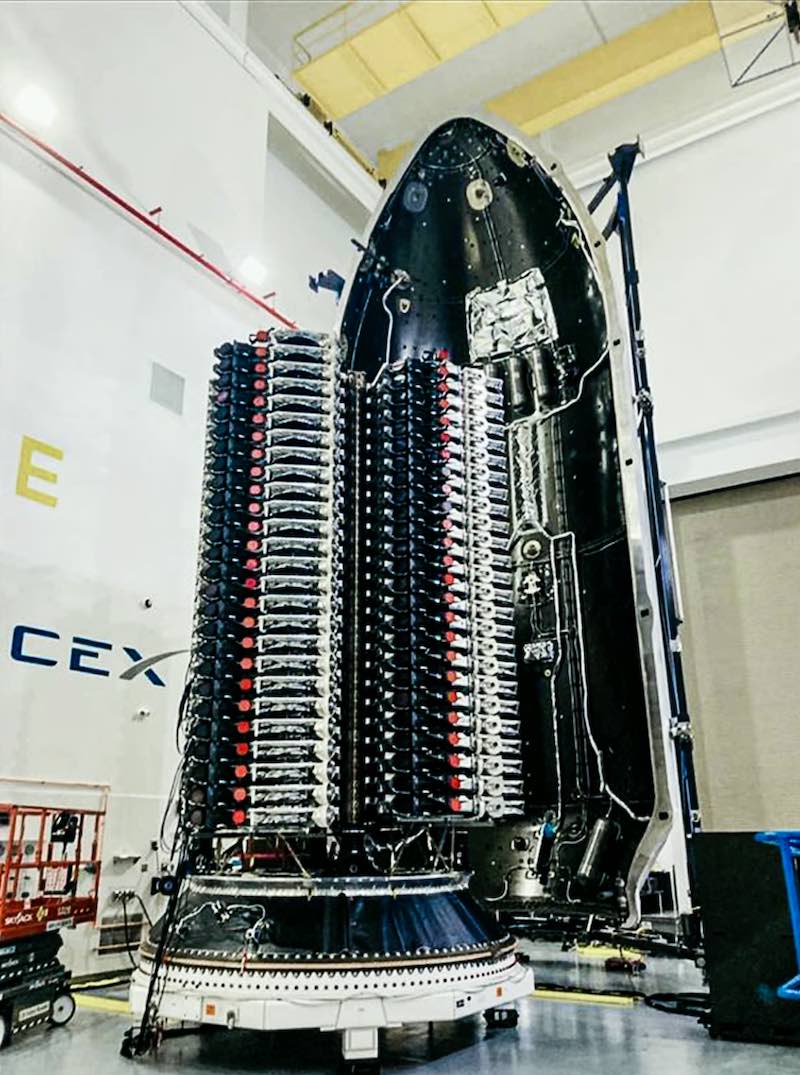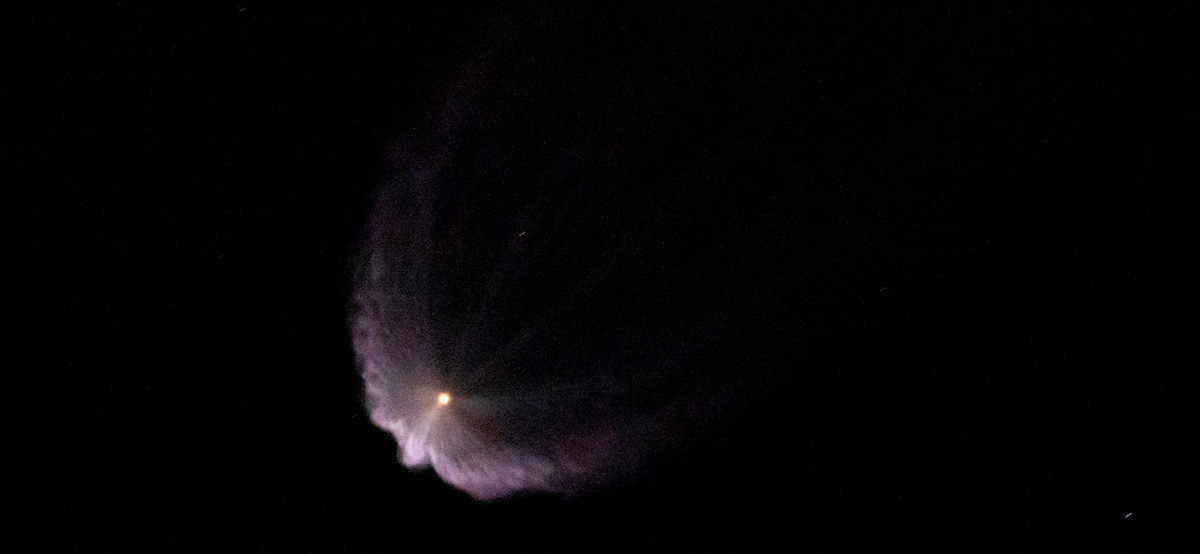
SpaceX delivered 51 more Starlink internet spacecraft to orbit Monday night with a successful Falcon 9 rocket launch from California, introducing new inter-satellite optical laser links to improve how the network relays broadband signals around the world.
The launch was the first dedicated Starlink mission from Vandenberg Space Force Base, located about 140 miles (225 kilometers) northwest of Los Angeles. The successful Starlink flight clears the way for SpaceX’s next Falcon 9 rocket to launch Wednesday night from Kennedy Space Center in Florida on the all-civilian Inspiration4 crew mission.
The Falcon 9 rocket deployed the 51 Starlink satellites into an orbit with a tilt angle of 70 degrees to the equator, inaugurating a new orbital “shell” to expand the reach and capacity of the privately-developed internet network.
Amid thick fog, the Falcon 9 rocket lit its nine Merlin 1D engines and lifted off from Space LAunch Complex 4-East at Vandenberg at 8:55:50 p.m. PDT (11:55:50 p.m. EDT) Monday, or 0355:50 GMT Tuesday.
The powerful kerosene-fed engines drove the 229-foot-tall (70-meter) rocket through the soupy fog layer within a few seconds, and the Falcon 9 streaked into a starry sky over California’s Central Coast.
After exceeding the speed of sound, the rocket accelerated downrange to the south-southeast from Vandenberg, following a trajectory roughly parallel to the coast of Southern California.
The Falcon 9 shut down its first stage engines and jettisoned the booster about two-and-a-half minutes after liftoff. The second stage ignited its single Merlin engine for a six-minute firing to attain enough speed to reach orbit.
Moments after second stage ignition, the rocket shed its two-piece, clamshell-like payload fairing to fall into the Pacific Ocean.
The first stage descended to a smooth propulsive touchdown on one of SpaceX’s rocket landing platforms, named “Of Course I Still Love You,” stationed a few hundred miles downrange in the Pacific Ocean. The booster on Monday night’s flight was designated B1049, and made its 10th trip to space and back, tying a record for the most-flown rocket in SpaceX’s inventory.
The drone ship will return the rocket to the Port of Long Beach in California for refurbishment and assignment to another mission.
After reaching an on-target orbit, the Falcon 9’s upper stage released the stack of 51 flat-panel satellites about 15 minutes into the mission. The deployment occurred over the remote Pacific Ocean outside the range of ground station coverage.
SpaceX confirmed the successful satellite separation as the rocket soared over a tracking antenna in Chile about 26 minutes after liftoff.

The rocket targeted deployment of the Starlink satellites in an elongated orbit with an apogee, or high point, of 213 miles (343 kilometers). The satellites, built by SpaceX on an assembly line in Redmond, Washington, will deploy solar panels and activate krypton-fueled plasma thrusters to reach an operational circular orbit at an altitude of 354 miles (570 kilometers).
The 51 satellites launched Monday will begin populating a new shell within SpaceX’s Starlink network. SpaceX completed the fleet’s first orbital shell after a series of dedicated launches from Florida over two years between May 2019 and May of this year.
The Starlink satellites launched so far give the network reach to high latitudes, but don’t provide global coverage.
“We’ve completed the first element of our network …which basically gets us to plus or minus 50 degrees, 53 degrees, 55 degrees (latitude),” said Gwynne Shotwell, SpaceX’s president and chief operating officer, during a panel discussion at the Space Symposium last month.
The next phase of the Starlink program, beginning with Monday’s launch, will expand the coverage to the polar regions.
“We were hoping to do so a little bit sooner, but we’re working on our laser communication terminals,” Shotwell said.
Since May, SpaceX has rushed to complete development of new inter-satellite laser terminals to put on all future Starlink satellites. The laser crosslinks, which have been tested on a handful of Starlink satellites on prior launches, will reduce the reliance of SpaceX’s internet network on ground stations.
The ground stations are expensive to deploy, and come with geographical — and sometimes political — constraints on where they can be positioned. Laser links will allow the Starlink satellites to pass internet traffic from spacecraft to spacecraft around the world, without needing to relay the signals to a ground station connected to a terrestrial network.
Youmei Zhou, a SpaceX engineer who hosted the company’s launch webcast Monday night, said the new Starlink satellites are a “huge leap forward” in technology.
“Most satellites don’t speak to each other directly,” she said. “Instead, they use radio frequency communications with a ground station to relay communications between satellites. The Starlink satellites launching today will be testing fully operational optical inter-satellite links, otherwise known as space lasers, to provide direct communications between the satellites without ground stations acting as an intermediary.”
The laser links could also reduce the network’s latency, or the time it takes for a signal to travel between destinations.
“By launching to a polar orbit, the satellites will able to see almost all the way to the poles, providing near global coverage,” Zhou said. “This means Starlink will be able to expand service and Alaska, Scandinavia, and other polar regions.”
The launch Monday night brings the total number of Starlink spacecraft SpaceX has launched to 1,791 satellites, including failed and decommissioned spacecraft, adding to the largest fleet ever put into orbit.
A tabulation by Jonathan McDowell, an astronomer and respected tracker of spaceflight activity, shows SpaceX currently has 1,420 operational Starlink satellites, with more than 100 additional craft moving into their operational positions in orbit.

Most of the Starlink satellites launched so far have deployed into a 341-mile-high (550-kilometer), 53-degree inclination orbit, the first of five orbital “shells” the company plans to complete full deployment of the Starlink network.
With that shell on the verge of having more than 1,500 active satellites, SpaceX is transitioning to a new phase of the Starlink program.
The completion of the first Starlink “shell” enables the network to provide high-speed, low-latency internet services to lower latitudes, such as the southern United States. The partial deployment of satellites into the first orbital shell initially provided service over northern regions of the United States, Canada, and Europe, as well as higher-latitude regions in the southern hemisphere.
SpaceX, founded and led by billionaire Elon Musk, is currently providing interim internet services through the Starlink satellites to consumers who have signed up for a beta testing program.
Aside from the 53-degree and 70-degree orbital shells, SpaceX’s other Starlink layers will include 1,584 satellites at 335 miles (540 kilometers) and an inclination of 53.2 degrees, and 520 satellites spread into two shells at 348 miles (560 kilometers) and an inclination of 97.6 degrees.
SpaceX aims to launch Starlink missions from Vandenberg at a pace of one flight per month. Starlink launches from Florida’s Space Coast are expected to resume as soon as October.
SpaceX has regulatory approval from the Federal Communications Commission for approximately 12,000 Starlink satellites. The company’s initial focus is on launching 4,400 satellites on a series of Falcon 9 rocket flights. SpaceX’s next-generation launcher, a giant rocket called the Starship, could also be tasked with launching hundreds of Starlink satellites on a single mission.
Echoing previous comments from Musk, Shotwell said last month SpaceX is concentrating on providing Starlink service to a small percentage of the internet service market unreachable with conventional fiber connections.
“We’re looking forward to continuing to enhance the network by putting more capacity in space, and really looking forward to truly connect those that are very difficult to connect– the 3 to 5% where fiber just does not make sense,” she said.
“Customers are great at selecting great service and great value, so we will find out over the next five or so years what is too much, and what’s not too much,” Shotwell said. “I do believe that there is insatiable demand for data.”
Shotwell said last month that SpaceX continues technology development to reduce the cost of user terminals it sends out to Starlink customers. SpaceX charges $499 for a Starlink kit, which includes a circular antenna, a modem, and other gear.
But Shotwell said earlier this year it costs around $1,500 to produce each user terminal. That’s already a reduction from the cost off the first version.
“I can say, not proudly, that with every customer we acquire, we lose money on the user terminal because the cost of that user terminal is higher than the average customer can afford,” Shotwell said last month.
SpaceX says more than 500,000 people have ordered Starlink service or put down a deposit. The company said it has shipped more than 100,000 user terminals to consumers.
Most elements of the Starlink architecture, such as SpaceX’s use of mass-produced satellites and reusable rockets, have helped keep costs down.
“Reusability was key, actually, to deploying this constellation, and our satellite technology, we were able to bring that to a reasonable place with this generation of the constellation,” Shotwell said. “I don’t want to say we failed because we made tremendous progress on the user terminal, but those are still expensive.”
She said user terminals later this year will cost “roughly half” of the current terminal. “And we think we’ll be able to cut that in half yet again,” Shotwell said.
Shotwell said supply chain issues, such as the global computer chip shortage, have delayed the rollout of the new user terminals.
SpaceX is one of several companies developing a global satellite-based internet network. So far, pace of launches for the Starlink network have outrun efforts by SpaceX’s competitors.
OneWeb, backed by the British government, has launched 288 small internet satellites since 2019. The OneWeb satellites, built by a joint venture with Airbus in Florida, fly at higher altitudes than the Starlink spacecraft. The difference in architecture means OneWeb can reach global internet coverage with 648 satellites, a significantly smaller constellation than Starlink.
The next batch of 34 OneWeb satellites is scheduled to launch Tuesday on a Russian Soyuz rocket.
Amazon is planning its own commercial satellite internet constellation, but hasn’t started launching. China is also developing a broadband network that could include thousands of small satellites.
“There are millions and billions of people that do not have access to decent internet,” Shotwell said. “So that’s a pretty big market. I am not worried about the number of organizations that are interested in doing this. I’m interested and concerned about their sustainability when it comes to the space environment.”
Email the author.
Follow Stephen Clark on Twitter: @StephenClark1.
